
Guests
- Shaun Burniesenior nuclear specialist with Greenpeace.
- Ira Helfandformer president of the International Physicians for the Prevention of Nuclear War, member of the international steering group of the International Campaign to Abolish Nuclear Weapons, as well as the co-founder and past president of Physicians for Social Responsibility.
Links
- "Greenpeace radiation investigation at Chornobyl to assess accuracy of IAEA data"
- Greenpeace
- Shaun Burnie on Twitter
- "Are Russia and NATO trying to wreck the NPT?"
- International Campaign to Abolish Nuclear Weapons
- International Physicians for the Prevention of Nuclear War
- Physicians for Social Responsibility
Safety conditions at Ukraine’s Russian-occupied Zaporizhzhia nuclear plant are “completely out of control,” according to the International Atomic Energy Agency. This comes as the Russian military has deployed heavy artillery batteries and laid anti-personnel landmines at the site in recent weeks. “Nuclear plants are extremely vulnerable to external attack in the context of a war zone,” says Shaun Burnie, senior nuclear specialist with Greenpeace, who says something as simple as the loss of power could unleash “massive releases of radioactivity” at rates worse than the Cheronobyl disaster of 1986.
Transcript
AMY GOODMAN: The head of the International Atomic Energy Agency is warning the situation at Ukraine’s largest nuclear plant, Zaporizhzhia, is, quote, “completely out of control.” In an interview with the Associated Press, Rafael Grossi said Tuesday, quote, “Every principle of nuclear safety has been violated [at the plant]. … What is at stake is extremely serious and extremely grave and dangerous.”
In recent weeks, the Russian military has deployed heavy artillery batteries and laid anti-personnel landmines at the plant. Ukrainian officials say Russia is using the nuclear plant as a base for its artillery, knowing that Ukraine cannot attack a nuclear power plant without risking a nuclear disaster. Zaporizhzhia is the largest nuclear power plant in Europe.
We begin today’s show with Shaun Burnie, senior nuclear specialist with Greenpeace, who has just returned from Ukraine, where he was conducting an investigation at Chernobyl, the site of the 1986 nuclear disaster. Russian forces occupied Chernobyl for a month immediately after the invasion of Ukraine began in February.
Shaun Burnie, welcome back to Democracy Now! Can you talk about the situation at Zaporizhzhia and what you found at Chernobyl?
SHAUN BURNIE: Well, thank you.
The situation at Zaporizhzhia, it’s unusual for Greenpeace to agree with the International Atomic Energy Agency, but Mr. Grossi is absolutely right to be deeply concerned. The occupation began on the 4th of March. And since then, hundreds of Russian forces, as well as state employees of the Russian nuclear state company, Rosatom, have been on the site. So that’s bad enough.
The fighting around the plant, if anything, is more serious in terms of what’s actually going on at the site itself, because nuclear power plants are dependent upon reliable offsite power, and already we saw, in March and April, the loss of so-called grid connection. These are incredibly important, because nuclear plants also require electricity to maintain operations, to maintain the facilities — for example, the cooling pumps that pump water into the reactors and keep the reactors relatively safe. And what we saw in March and April was a loss of grid in a number of grid lines, and the reason for that was because of fighting 50, 60, 80 kilometers from the actual site. So, even if nothing happens at the site itself, nuclear plants are extremely vulnerable to external attack in the context of a war zone. And that’s exactly what we are in the situation at the moment in southern Ukraine.
NERMEEN SHAIKH: And, Shaun, you’ve said that the situation, of course, is extremely high risk in Zaporizhzhia, but you’ve also suggested that the role of the International Atomic Agency is highly political. Could you explain why?
SHAUN BURNIE: It’s a really complicated situation. This is a nuclear plant in Ukraine, obviously, but it’s under Russian military control, with the Russian nuclear state agency, Rosatom, on site. And the IAEA and Mr. Grossi have been trying to get access for a number of months. The problem is, if you, as an IAEA, go to Zaporizhzhia, are you therefore getting the approval of the Russian state, the Russian government, to access a nuclear facility in another country that actually still is a sovereign nation and for which the Zaporizhzhia plant still belongs? So there’s lots of behind-the-scenes tensions in terms of whether the Russian state has any right to say to the IAEA, “Yes, you can come and visit us.” So, the politics of this are really complicated.
It’s not really clear to us what safety role the IAEA would play. We have Ukrainian nuclear employees working on the site. We have Russian military, and we have Russian state nuclear agency people. So, what role does the IAEA play in that? It has a safeguards function, which is to ensure that nuclear material is not diverted for military purposes, but there’s absolutely no evidence that any nuclear material on the Zaporizhzhia site will be diverted by the Ukrainian government at this stage. That’s clearly ridiculous. And the Russians, they’ve got so many nuclear weapons and nuclear material in their own country, they don’t need to divert from Zaporizhzhia. So, it’s not really clear what is going on with regards the IAEA’s ambition to go there. I think, in part, it’s also driven by Mr. Grossi’s personal ambition. He seems to want to be seen as the savior of everything. And actually, the situation is a lot more serious than the individual ego of any one particular individual at a U.N. agency.
NERMEEN SHAIKH: Shaun, we’ll turn in a second to your report, the Greenpeace report, the investigation into the Chernobyl plant, which Russian forces occupied during their invasion for over a month in the early days. But could you talk about what your concerns are with respect to Zaporizhzhia, people saying that it could actually — if the plant is damaged, the situation could be worse than what happened at Chernobyl?
SHAUN BURNIE: Well, clearly, it’s an intolerable situation that Russian military, Russian nuclear state employees are occupying Ukraine’s nuclear power plant at Zaporizhzhia. For the workers, for their families, whose job it is to try and maintain the safe operation of those reactors, that’s clearly an outrageous situation, and it must be terminated and ended as soon as possible. The only way that can happen is for the Russians to withdraw immediately. Again, that’s not going to happen.
So, what sort of scenarios are the most severe? The loss of cooling function to the reactor cores — there’s three reactors out of six that are currently operating — that would be a major problem. We know that the generators that provide emergency power at Zaporizhzhia have got long-standing problems, not particularly reliable. The battery power is also extremely limited. So, loss of power is really the most severe issue that concerns us.
Also at the site, there are thousands of tons of spent fuel. That’s the highly radioactive fuel that comes out of the reactors. Much of that is in dry stores, which are of less concern. But the material that’s in the pools — that’s the swimming pools that are inside the reactor buildings — they need to be constantly cooled, which means that in the Zaporizhzhia site you’ve got much more radioactivity than was ever released by Chernobyl, in a war zone, where the personnel are under direct military threat at all times. So the ability to respond to any event, particularly a more severe event like loss of cooling, is extremely compromised. So, at that point, you’re looking at potential massive releases of radioactivity, potentially even greater than Chernobyl. That’s not scaremongering; that’s just the reality of having nuclear power plants in a war zone.
AMY GOODMAN: And on the issue of Chernobyl, talk more extensively about what you found in your report, that says that the damage at Chernobyl, as you said, is so much worse than we understood.
SHAUN BURNIE: So, for a number of months, we’ve been in discussion with the Ukrainian government, and we had the opportunity, a unique opportunity, to actually conduct a survey, a radiation survey, and also to meet with scientists whose responsibility is to manage and oversee this enormous exclusion zone around the nuclear plant from 1986, still highly complex, highly radioactive, with many, many problems.
And then the Russians occupied on the 24th of February, left on the 30th of March. And the reports coming out at that time seemed to be confused, and so we basically went in there to, A, listen and hear from the scientists who experienced the occupation — and these are laboratories that are fulfilling vital safety work on radiation moving through the environment. This is an ongoing disaster site. And we clearly saw that the Russian military had damaged, destroyed parts of the laboratory, stolen databases, smashed computers, removed hard drives.
But then we also went into the area which they managed. It’s 2,600 square kilometers. And we were only able to go to one very small specific area, because, unfortunately, the Russian military have also decided to place landmines throughout the territory, some of it organized and some of it completely chaotic, tripwires, anti-personnel mines. So, the impact on the scientists whose job it is to monitor radioactivity in the Chernobyl zone, also to provide warnings to firefighters, all of that has been compromised by the Russian military occupation. What we found was that radioactivity levels, in particular one area where the Russian military were, yes, it was high, but if you moved only 500 meters away, it was many, many times higher.
And so, the idea that this is a situation under control, that the radiation levels are normal — which is what the IAEA and Mr. Grossi communicated in April — is clearly not true. And so, the situation is incredibly complex. And basically, turning this into soundbites saying that things are normal, it doesn’t give any information whatsoever. So we have some severe doubts about the accuracy of what the IAEA was trying to communicate back in April. This is an ongoing crisis at the Chernobyl site. The workers, the scientists, the state agency, they need as much help as possible, because this is of national and international significance, in terms of what radioactivity is doing to the environment there and what it potentially poses as further threats in the future.
AMY GOODMAN: Shaun Burnie of Greenpeace, I wanted to bring in Dr. Ira Helfand, the immediate past president of the International Physicians for the Prevention of Nuclear War, which won the Nobel Peace Prize, also co-founder and past president of Physicians for Social Responsibility and serves on the international steering group of the International Campaign to Abolish Nuclear Weapon, which also won the Nobel Peace Prize. Dr. Helfand, as you listen to this report, Shaun Burnie just back from Ukraine, both about what’s happening at Zaporizhzhia, where the Russians are basing themselves there so the Ukrainians cannot attack because that would create a nuclear catastrophe, and his findings at Chernobyl, your response?
DR. IRA HELFAND: Well, you know, clearly, the situation around the nuclear reactors in Ukraine is extremely worrisome and it underlines, as Shaun was saying, the fact that these reactors are not designed to function in a war zone. And it calls into question, I think, the entire nuclear power enterprise globally, because we just can’t afford to run the risk of this kind of catastrophic accident occurring, with the enormous public health implications that would follow from that. Tens of thousands of people were exposed to doses of radiation from Chernobyl that led to them developing cancer and dying. The exact number is very difficult to come by, but the estimates are that it’s at least in the tens of thousands, and perhaps higher. And we can’t afford to continue to operate these nuclear reactors, given those kinds of risks.
AMY GOODMAN: Well, we want to thank Shaun Burnie for being with us, Shaun Burnie of Greenpeace, who’s just back right now from Ukraine, where he investigated what took place at Chernobyl and is talking about the situation at Zaporizhzhia. And we’ll link to your Greenpeace report, “Investigation Inside the Chornobyl Exclusion Zone.” Dr. Helfand, we’d like you to stay with us as we talk further about the threat of nuclear war. Stay with us.

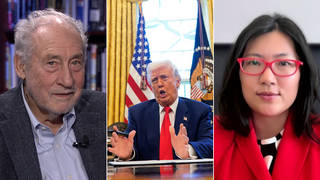
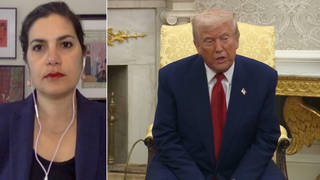
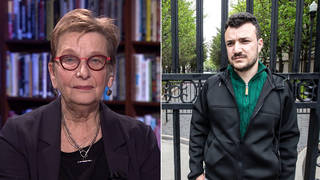
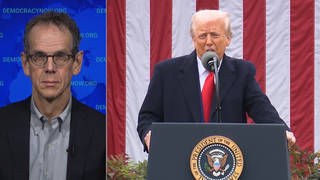





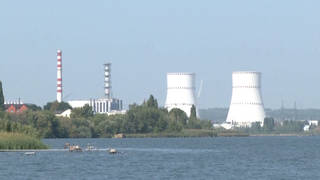
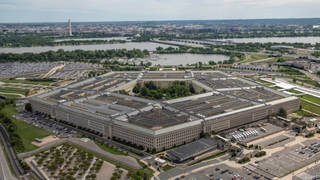
Media Options